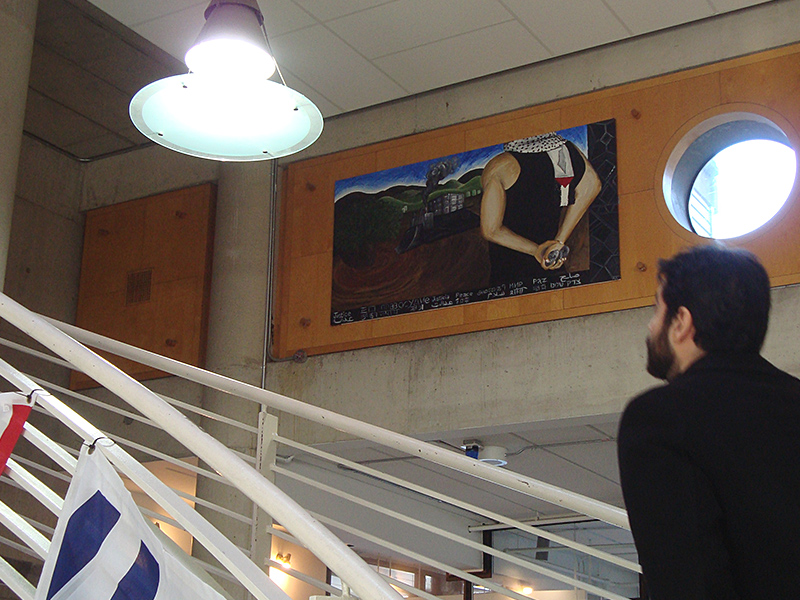A few months ago, my art was included in two exhibitions in two different galleries in the same building in Toronto. At the opening receptions, my family passed another gallery with a large red and black sign announcing an art exhibition about living in Palestine. Naturally, it caught our attention. The first thing we saw in that gallery was a video showing an artist’s studio in ruins. The subtitles said that the studio was destroyed by Israeli soldiers. I felt alienated in my own art community. This visceral response led me to explore my Jewish identity as a contemporary Canadian artist.
Artists and curators construct emotional and intellectual responses that ultimately lead to trends in society. We are currently in an age of identity politics. Identity is made of many intersecting factors, such as gender, race, ethnicity, ability and class. Intersectionality is understood as interlocking systems of oppression. Hearing the voices of artists of every identity and ensuring their freedom of artistic expression is vital.
There has, as of late, been an increase in art depicting the Palestinian cause exhibited in Canadian art galleries. There are well-organized and well-funded international art organizations that foster and support contemporary art from the Arab world that partner with museums and art galleries around the world, including in Canada. We know these artists identify as Palestinian because they include this information in their biographies, even when their work has nothing to do with the Palestinian cause.
At the same time, contemporary Jewish visual artists rarely speak of their Jewish identity in their bios and artist statements. While Jewish identity is part of the Toronto theatre and music scene, Jewish visual art events tend to focus on art appreciation, art collecting and strengthening our own community, rather than participating in grassroots intersectional identity politics.
Anti-Semitic tropes and stereotypes have been around for so long that many people who consider themselves open-minded and humanitarian thinkers – including artists, curators and university professors – have internalized them as truisms. When exposed to these ideas many times over many generations, people accept these stereotypes as truth, without thinking about them critically. Critical thinking is harder when everyone collectively believes what is socially constructed and accepted as true. Some well-meaning individuals and organizations suppress their own critical thinking due to political correctness, to avoid appearing racist and bigoted. But by doing so, they end up espousing age-old anti-Semitic tropes.
Contemporary anti-Semitism includes silencing stories and voices, exclusion and complacency. On college campuses and social media, buzz words such as “apartheid” and “occupation” are used to describe Israel. Zionism is falsely associated with racism. The BDS movement has become socially accepted in many circles, including some that are Jewish. Humanitarian organizations often get information from the United Nations Commission on Human Rights, which discriminates against Israel and perpetuates institutional anti-Semitism.
There is a massive rise in global anti-Semitism right now, and Jewish voices are being sidelined. It’s ironic that with the current shift away from binary thinking toward pluralism, dichotomies are still applied to the Jewish community. Some of these include oppressor-oppressed, privileged-marginalized. It is important to avoid perpetuating dichotomies, such as good versus evil. It is much more richly nuanced than that.
While Jews are actually a very small minority, constituting only 0.06 per cent of the global population and one per cent of Canada, many currently perceive Jews as being less oppressed than others. And when Jews are seen as being privileged, anti-Semitism is sidelined. With all of the intersectional discussions, it interests me that lighter-skinned Jewish people continue to let people think they are white, when white people don’t really accept Jews as white. While I might be racialized as white, I identify as Jewish.
So, while Jewish people who look like me benefit from white privilege when, for example, we don’t worry about some racist store owner thinking we are shoplifting, we do not belong to the white side of a dichotomy. Jewish people have a long history of oppression that is very different from what is lumped into “white.”
We know in the Reform community that there are many different ways of being Jewish and that the Jewish community is nuanced in its beliefs and practices. Our skin colours are diverse. Our social economic situations are varied. The Jewish people, as a people, are resilient. In many cases, after fleeing or surviving persecution, and depending at where we are in the immigration cycle, we can become successful. But there are numerous Jewish people who are not economically privileged.
Do Jewish visual artists worry about being alienated in the arts community? We can help the Jewish community by telling people we are Jewish. Feminism, the arts and academia will all benefit from people outing themselves as Jewish, since doing so helps break down the stereotypes of what people think Jewish is.
Our Jewish community is divisive because of differences in politics, practise, social class and viewpoints. In order to stay viable in our current context, we need to partner with as many willing organizations and individuals across various communities, including “competing” Jewish organizations. When we label someone as too politically right or left, we stop listening and miss many learning opportunities.
As only one per cent of the Canadian population, the Jewish community needs to respect differences and seek to understand people who are different from ourselves. We need to accept people as part of our community who have different political views and points of view. We can assume that most people who are working toward social justice have good intentions. There are many different ways to be Jewish, Canadian and all other identities. We are all human. We need to listen, be respectful and have more conversations with various communities. We must be critical thinkers, noticing who is telling the story and what part is being left out. We need to speak up and use our voices to create positive change.
